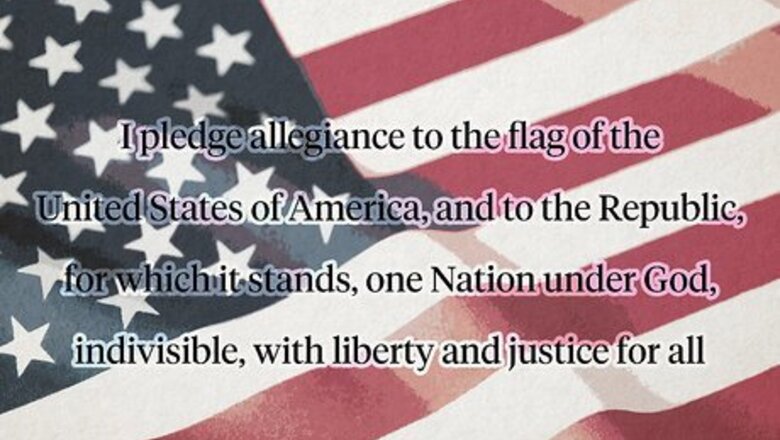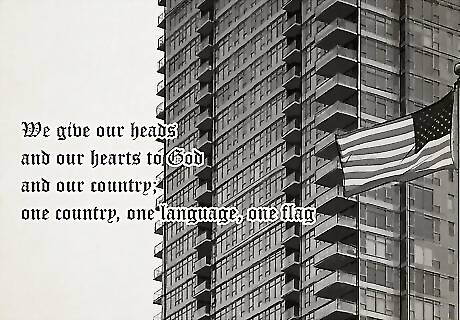
views
- Reciting the Pledge of Allegiance is a promise of loyalty to the United States that became popular after the Civil War.
- The first version was written in 1892 by Francis Bellamy to use in celebrations of the 400th anniversary of Christopher Columbus’ voyage to the Americas.
- Congress officially adopted the pledge in 1942, and the controversial words “Under God” were added during the Cold War in 1954.
Why do we say the Pledge of Allegiance and what does it mean?

Reciting the Pledge of Allegiance is a promise of loyalty to the U.S. The U.S. flag represents the beliefs and principles of the country, and pledging allegiance to it is a way to show loyalty to those principles. Today, this pledge is recited by students at the beginning of the school day. The sessions of the House of Representatives and the Senate also begin with the pledge. The pledge reads: “I pledge allegiance to the flag of the United States of America, and to the Republic, for which it stands, one Nation under God, indivisible, with liberty and justice for all.” Pledging allegiance to the “Republic” means pledging loyalty to a government where the people vote for their own representatives. “One Nation under God, indivisible” means all 50 states are united as a single Republic under God and cannot be separated from each other. “With liberty and justice for all” means that all Americans have the freedom to pursue life, liberty, and the pursuit of happiness, and have the right to be treated fairly.
History of the Pledge of Allegiance

The idea of reciting a pledge became popular in 1885. In 1885, Civil War veteran Colonel George Balch created a vow to the American flag. It read: “We give our heads and our hearts to God and our country; one country, one language, one flag.” Several schools adopted this pledge.

The first version of the pledge was written by Francis Bellamy in 1892. Bellamy, a Christian socialist and former Baptist minister, wrote for the “Youth’s Companion” magazine. In 1892, he was asked to write a new pledge to use in celebrations of the 400th anniversary of Christopher Columbus’ arrival in the Americas. It read: “I pledge allegiance to my Flag and the Republic for which it stands: one Nation indivisible, with Liberty and Justice for all.” Bellamy also convinced President Harrison to declare Columbus Day a national holiday.

From 1880 to 1920, more than 20 million immigrants moved to the U.S. To prevent these immigrants from thinking about the flag of their birth country, the American Legion replaced the words “my Flag” with “the flag of the United States” in 1924. The words “of America” were also added after “United States.”

Congress officially adopted the Pledge of Allegiance in 1942. The pledge was included in the revision of the U.S. Flag Code, which says to recite it facing the flag with your right hand over your heart. The official name, “The Pledge of Allegiance,” was adopted in 1945. It read: “I pledge allegiance to the flag of the United States of America, and to the Republic, for which it stands, one Nation, indivisible, with liberty and justice for all.” When wearing a non-religious headdress, remove it with your right hand and hold it at your left shoulder, with your hand over your heart. When in uniform, face the flag and do a military salute, with your right hand over your brow. Before 1942, people recited the pledge with their right arm extended toward the flag and their hand outstretched. During WWII, Americans worried that it looked like a Nazi salute, so Congress changed the gesture.

The words “Under God” were added to the pledge on June 14, 1954. During the Cold War, members of Congress passed a law to add “Under God” to the pledge to emphasize the differences between the U.S. and atheist Communist countries, like the Soviet Union. The Knights of Columbus (a Catholic fraternal organization) was one of the first groups to call for the addition of “Under God” in 1952. U.S. Representative Louis C. Rabaut was persuaded by the Knights of Columbus’ petition and introduced a law to add it to the pledge. In February 1954, President Eisenhower attended a sermon by Reverand George Doherty who convinced him to officially sign the phrase into law. Two years later, Eisenhower also made “In God We Trust” the official motto of the United States.
Controversies of the Pledge of Allegiance

Some say that the use of “Under God” in the Pledge is unconstitutional. The words “Under God” have been opposed in court since they were added. In court, some argued that the First Amendment (freedom of religion and speech) protects the right of students to refuse to say or stand for the Pledge of Allegiance. Others argue that children can’t give consent or understand the pledge of loyalty they’re making.

Students are no longer required to say or stand for the Pledge of Allegiance. In 1943, the Supreme Court ruled that students cannot be forced to say the pledge. In 2004, the 11th Circuit Court of Appeals ruled that students are also not required to stand during the pledge. In a notable 2002 case, Newdow v. U.S. Congress, Atheist Michael Newdow argued that his daughter had to watch her teacher say that there is a God, which is a violation of the First Amendment. The Ninth Circuit ruled in Newdow’s favor, however, the Supreme Court said Newdow didn’t have legal standing to bring the case.



















Comments
0 comment